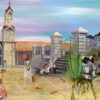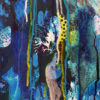Have a Question?
Please allow 24 hours for me to respond to any questions Royston, UK stacey@byleigh.comPayment Options
Newsletter Signup

 Considering Disability… interrupted by FOFU
Considering Disability… interrupted by FOFU 
 Considering Disability… interrupted by FOFU
Considering Disability… interrupted by FOFU
Featured Image: close up of We Jammin Still by Leigh
29 Jan 2019
I’m pretty sure I have encountered this concept before. The Mighty Sparrow’s “Dan is The Man” comes immediately to mind. It’s a calypso that does a wicked dissection of the education system that was set up in Trinidad & Tobago for the freed slaves and their descendants. The thing is, as many times as I’ve listened and sang along to this song, I didn’t know that Sparrow was engaging in critical pedagogy; and he’s not the only one. So many calypsoes of my youth are rooted in critical social analysis and commentary that I’m sure there are more I’ve missed over the decades. So CP my darling, it’s nice to meet you formally and get your name this time!
Right… My class has been given a video to watch about critical pedagogy. This blog is just a quick list of my thoughts after watching this video.
About Critical Pedagogy
UK Higher Education
Critical Pedagogy & Me
I teach in two ways – with my art and through my art.
Teaching with my Art is more using it and the artistic process as the teaching tool. For example, using the teaching of Carnival craft techniques with 8 and 9 year olds to bring home a sense of pride in their Caribbean heritage. Some teaching moments were:
Teaching through my Art is when I use the painting as the teaching point and let it interrogate the viewer for itself. Some examples are:
Surprises
Surprised (don’t know why though…)
The two clips about Native Americans – the animated one about if he knows how to cross the street, and even worse, the white man who married the Native woman. She has no lines to say, she is meek and quiet and she is surrounded by all these white men talking about her like a charity case. It ends on a real low point “I’ll just call you Janie” because he life before now doesn’t matter apparently. Just wow!
And Lessons
I think I knew this before but this made all the pieces really solidify in my mind – the use of education as weapon for mass oppression. I also so just started reading Teaching to Transgress so that lesson is really being pressed in.
The loss of history – also another thing I feel like I knew but hadn’t quite put together in my mind. How many stories of First Peoples all over the world have been lost because their knowledge and experiences weren’t valued by their oppressors? So much history for so many people lost and all its been replaced with is… well… lies.
I feel like this video brought many loose things together and then gave them very sharp focus.
More thoughts…
Still thinking…. holisitic teaching? I’m listening to Teaching to Trangress right now and that’s answering many of my questions.